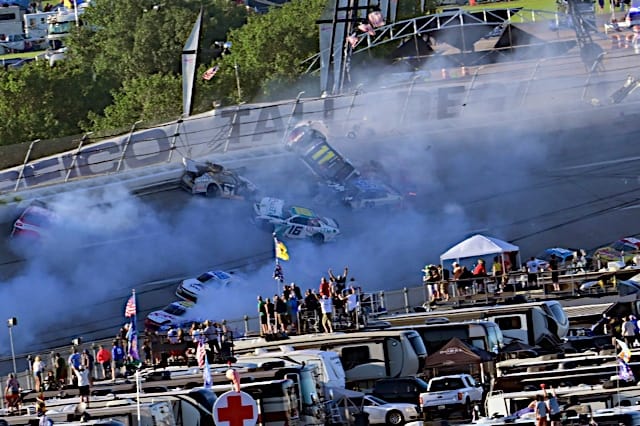They say it all goes quiet.
One of the scariest scenarios to have to watch play out in racing is when a racecar gets turned at such an angle that it gets airborne. Even before the replays, it sometimes seems like slow motion. The car almost dances for a split second before reality careens in. Then, even watching on television, you can hear the car slam back to earth, and time moves double-quick to make up for the moment it stopped.
Drivers who have been in the situation say that in the moment the car takes flight, all goes quiet—until the return to earth.
Two cars flipped during Saturday’s (April 22) NASCAR Xfinity Series Ag-Pro 300 at Talladega Superspeedway; Blaine Perkins climbed from his car afterward but was transported to a local hospital for further evaluation and treatment. He returned home to North Carolina on Monday. Daniel Hemric wasn’t hurt when his No. 11 came to rest on its roof, but that scenario is always tense as the safety crew has to turn the car back over before they can get the driver out, and it seems to take an eternity.
Sunday’s NASCAR Cup Series race didn’t feature anything quite so spectacular. There were some bad blocks that led to typical superspeedway mayhem, and one triggered a scary incident when Kyle Larson spun into the path of Ryan Preece, resulting in what Preece called the hardest hit of his career. The roll cage on the right-hand side of Larson’s car was alarmingly mangled. Nobody wants to think about the elephant in the room: what if that had been the driver’s side?
NASCAR has done just about everything in its power to make the sport as safe as 40 high-powered, ton-and-a-half machines thrown together on an enclosed surface can be.
And it’s succeeded. There hasn’t been a fatality in a national series since 2001; 22 years now. At the time of Dale Earnhardt’s death, there were no mandatory head and neck restraints, no SAFER barriers encircling racetracks and no shock-absorbing foam surrounding the cockpit. Drivers weren’t even required to wear a full-face helmet.
Earnhardt’s fatality is the last under the NASCAR banner, and for two decades, drivers have walked away, sometimes banged up and sometimes with injuries that are career-ending, yes, but alive. The current Next Gen car raised concerns about rear-end collisions, which NASCAR has addressed since. Is there room for more?
There always is and…
Click Here to Read the Full Original Article at …

